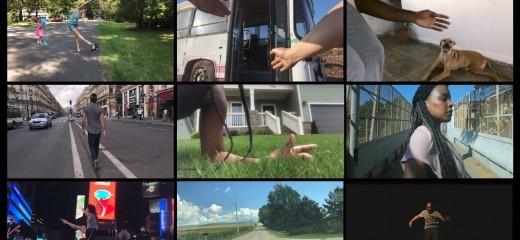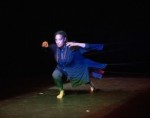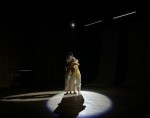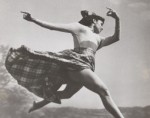
Distancing Elides in 3 x 13, Yaa Samar!’s Outstanding Multinational Film
by Jonathan Stein
Creating dance remotely is old hat for Palestinian-American choreographer Samar Haddad King. To be an artist in occupied Palestine compelled visa denials, separation, and border closures, conditions that have led her Yaa Samar! Dance Theater (YSDT) company and fellow artists to video conferencing and social media communication.
Amidst the current abundance of dance film, YSDT's new film, 3 x 13, choreographed/co-created by King, stands out as an emotionally and visually compelling testament to the human spirit. The film, directed/co-created by Eimi Imanishi, shows the unique power of dance to tell stories of many who would be voiceless. King has gathered 12 dancers* from eight countries, speaking five languages in the film, and each creating a three-minute personal short story of a transformative experience in their lives. Each dancer performs in their locale and narrates in their own language with a viewer’s option for English or Arabic subtitles. The dancers also film on their own phones. Their gripping narratives portray childhood trauma, parenthood, exile, loss, racial, ethnic and gender aggression, and an embrace of dance as a life’s calling—an embrace clearly shared by all 12.
The film’s preamble asks the viewer to become an active traveler and to “chart your own course” among these multinational stories. It first offers us a 12 square grid, each representing one of the film’s narratives, allowing us to select one or to have them automatically segue from one to another. The grid itself becomes a 13th composite film, presenting the simultaeity of the moving ensemble and rendering its own forceful visual statement of the human condition in the pursuit of self-determination.
King stated in an interview with an Egyptian newspaper** that each dancer learned the same movement phrases, but she encouraged each to retain their individuality in movement and were also part of the discussion with Imanishi and King about locations for their shoots. At critical narrative junctures of the story, each dancer inserts an expressive improvisation marking their individual responses. These latter segments include Malian Lassina Kone’s exorcism of the traumatic memory of the death of childhood schoolmates; Carlos Luis Blanco Ramos’ exuberant Havana rooftop solo to his coming out as gay and a dancer as a teenager; and Zoe Rabinowitz’s flowing statement of rebirth after a failed relationship.
The condensed narratives, performed in a vivid array of dancer-chosen, site-specific settings, are generally impactful, but what adds to their power is their shared choreography and cinematic construction that masterfully weaves these disparate stories into a satisfying whole cloth. Dancers incorporate a single leg circling on the ground; yet that surface changes to a cracked urban sidewalk, a wooden dockside, or smooth stone domestic floor. Hand gestures predominate, especially a single hand or sometimes two hands with a pointed finger, suggesting direction or pause or an emphasis of an aspect in the narrative. All performers are directed to hold their phone cameras in the same settings: in the left hand, the right hand, at the belly, and then setting the phone down apart from the dancer (especially for the full-body improv solos, often the most dynamic segments). These camera positions capture angled views of the body and neighboring space, or distant architecture, sky and landscapes, that provide visual structural ties across the narratives.
The power of the narrative dances have their greatest impact when the locale connects directly to the subject of the narrative. Ambar Luna Quintanar chooses the urban streets in her Chiapas town and speaks of her memories of male aggression while walking them. As she finds empowerment among other women, her talking dance reveals that these streets “lost power over me, and now they belong to me.” Samaa Wakim uses bus transits in Palestine for her narrated dance that reveals the unsettling, mutual passenger “game” of suspicion and stereotyping of Arab and non-Arab passengers.
For each film Lou Tides sets original music providing a diverse array of story-specific and enhancing accompaniments that range from industrial metallic to haunting vocals to soft, bell-like synthesizer sounds.
3 x 13 is a rare achievement, and a loving gift that in these dark times, remote can become together.
Yaa Samar! Dance Theater’s 39 minute film 3 x 13 can be accessed here for free (or with donation) and opened on Feb. 20. Flushing Town Hall in Queens, NY will present a livestream matinee on Sunday, March 21, featuring a curated selection of films and a panel of six collaborating artists. On March 22 at noon, Flushing Town Hall will livestream a dance class featuring techniques and methods used in the making of 3 x 13.
*The dancers involved in the project are: Zoe Rabinowitz (Vermont, US), Carlos Luis Blanco Ramos (Havana, Cuba), Nagham Salah Othman (Cairo, Egypt), Samaa Wakim (Mi’ilya, Palestine), Nidal Aboo (Paris, France), Kayna Wilson (Alabama, US), Lassina Kone (Mali/France), Yukari Osaka (New York, NY), Ambar Luna Quintanar (Chiapas, Mexico), Jaewoo Jung (Seoul, South Korea), Kristin Clotfelter (North Carolina, US), and Mohammed Smahneh (Nablus, Palestine).
** An English translation of the interview in Al-Ahram Hebdo, published in French, was provided by Zoe Rabinowitz, associate director of YSDT and project manager for the film.
Read thINKingDANCE’s previous coverage of Yaa Samar! Dance Theater here.
By Jonathan Stein
February 21, 2021










